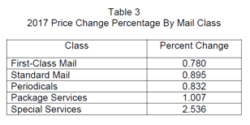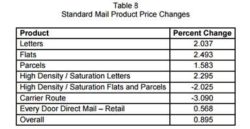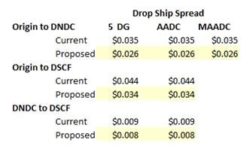October 24, 2016
As you have already heard, the U.S. Postal Service filed on October 12th its next postage adjustment to take effect at midnight on January 22, 2017, pending Postal Regulatory Commission (PRC) approval. We have listed below a few of the highlights.
The official filing at the PRC is listed as: R2017-1 United States Postal Service Notice of Market Dominant Price Adjustment. You can link to it here.
The incentives for Full-Service Intelligent Mail Barcodes (IMB) remain the same at three-tenths of a cent for First-Class and one-tenth of a cent for Standard Mail (now being re-branded Marketing Mail) and Periodicals. At the same time, USPS will begin next month to assess penalties on mailers who do not meet their minimum requirements for Full-Service IMB.
The weighted-average price increases for each class of mail are listed in Table 3 below. Individual price changes will vary above and below the averages. It is important that you work with your mail service providers to determine the specific impact on your mail.
First Class Mail
First Class Mail overall will be increased by a weighted average of 0.780 percent. But there are big differences between specific types of First Class Mail.
The proposal includes a two-cent increase in the price of a First-Class Mail Single-Piece Forever Stamp, returning the price to 49 cents, which is what it was prior to the removal of the exigent surcharge.
As the stamp rate is going up so much more than the cap of 0.78 percent, 4.3 percent, the USPS had to lower, or not increase, other types of First Class. Reduced prices include metered mail, presort letters and cards, and 5-digit automation letters. And no increases were proposed in additional ounces and in First Class Mail International. Also, commercial mailers will now be able to mail 3.5 ounces at a single price versus two ounces currently, effectively a price reduction.
The Postal Service justified hitting single piece users of First Class much harder than commercial users with several rationales:
- It “…will not unduly curtail mail usage or cause significant hardship for the mailing public.”
- “…[t]he stamp price was 49 cents during the more than 27 months in which the exigent surcharge applied.”
- “…any negative impacts from this increase are far outweighed by the substantial revenue benefits from the change…”
- “…the rate relationships resulting from the increase are just and reasonable within First-Class Mail.”
- “The 49-cent stamp price is also consistent with the rate of inflation for the 10-year period during which market dominant prices have been subject to the CPI price cap under the Postal Accountability and Enhancement Act of 2006 (PAEA).”
Standard Mail
Standard (Marketing) Mail will increase a weighted average 0.895 percent, and the following category averages:
Letters
Smaller nonprofits that mail Standard Letters from origin will be rewarded with a substantial rate reduction. All others that drop ship will be hit with large rate increases.
While the piece presort rate for Mixed AADC and 5-Digit have gone down, the drop ship discounts have been reduced by $9 and $10 per 1000, which increases the DNDC and DSCF entered letters by 2 to 4%. The spread from DNDC to DSCF has decreased from $9 to $8 per 1000. The 3-digit rate cell has been removed.
Flats
In no category is it more true than on Standard Flats that mailers must work with their service providers to figure out their specific impact.
The new pricing includes an increase of the piece/pound breakpoint from 3.3 to 4.0 ounces for Flats and Parcel shaped pieces to encourage mailers to include more content.
Flats Sequencing System (FSS)-specific rates for flat-shaped pieces will be eliminated, specifically: DFSS entry, FSS Scheme Pallet/Container, and FSS other Pallet/Container.
They will be replaced with appropriate 3-Digit, 5-Digit, Carrier Route, and High Density prices.
While the Standard Mail class overall is to be increased by 0.895 percent, Standard Mail Flats will go up by a weighted average of 2.493 percent. This responds to a PRC directive for the Postal Service to pull Standard Mail Flats out of their underwater status. Cost reductions also would improve cost coverage without impacting customers. Carrier Route was reduced by an average of 3.09% in part due to the removal of the FSS rates, and High Density reduced by 2.025%.
As a mailer of Standard Flats, remember that the USPS breaks out Carrier Route from Standard Flats. So while Standard Flats postage will increase about 2.5 percent, if your mailing includes Carrier Route pieces that have been paying FSS rates, your overall postage should not see the same increase.
Mailers will still do their mail prep to the FSS requirements based on the DMM, but the FSS price cells have been removed from the 2017 rates. This will enable mail previously qualified as Carrier Route to again pay at the CR rates. This change will allow the USPS to add zip codes to and change FSS zones as needed without negatively impacting the mailers postage spend.
While the Letter drop-ship discounts have decreased, the Flat drop ship discounts for pieces four ounces and less have increased from $33 per 1000 pieces for DNDC and $43 per 1000 for DSCF to $40 for DNDC and $52 for DSCF (increasing the spread from $10 to $12 per 1000). The drop ship pound discounts have remained the same as in 2016, $16.10 per 100 pounds for DNDC, and $20.90 per 100 pounds for DSCF.
Periodicals
The Periodicals overall is to be increased by a weighted average of 0.832 percent. Like Marketing Mail, it is important to work with your mail service provider to ascertain the real impact on your mail.
The Postal Service summarized the impacts on Periodicals as follows:
- On average, large circulation publications will pay 0.5 to 3 percent less in postage due to this price change.
- On average, heavier weight mailers will also see their postage decline around 0.5 percent to 1 percent.
- On average, large Nonprofits mailers will see changes in their prices from 0.9 percent increases to declines of 3.3 percent.
- On average, smaller, low circulation publications (less than 150 thousand per issue) will see above average increases due to small circulation and lighter weight pieces.






Leave a Reply